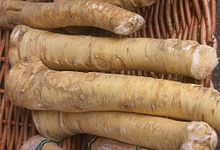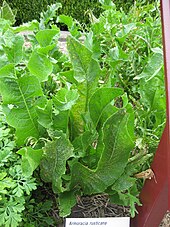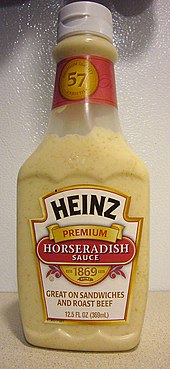| Revision as of 20:13, 13 February 2014 editWetman (talk | contribs)Autopatrolled, Extended confirmed users, Pending changes reviewers, Rollbackers92,066 edits →History: corrections, details, ref← Previous edit | Revision as of 20:24, 13 February 2014 edit undoAnomieBOT (talk | contribs)Bots6,587,581 edits Fixing reference errorsNext edit → | ||
| Line 23: | Line 23: | ||
| ==History== | ==History== | ||
| Horseradish, probably indigenous in temperate Eastern Europe, where its Slavic name ''chren'' seemed to ] more primitive than any Western synonym. Horseradish has been cultivated since antiquity.<ref>J.W.Courter and A.M. Rhodes, "Historical notes on horseradish" ''Economic Botany'' '''12'''.2 April=May1969pp156ff</ref> According to ], the ] told ] that the horseradish was worth its weight in gold.<ref name=healingfoods>{{cite book|last=Murray|first=Michael T.|title=The Encyclopedia of Healing Foods|year=2005|publisher=Atria Books|location=New York|isbn=978-0743480529|coauthors=Lara Pizzorno, Joseph E. Pizzorno}}</ref> Horseradish was known in ] in 1500 BC.{{cn}} ] listed horseradish equally as ''Persicon sinapi'' (''Diosc.'' 2.186) or ''Sinapi persicum'' (''Diosc.'' 2.168),<ref>Early Modern translators of Dioscurides offered various names:.</ref> which .</ref> ] discusses the plant in his treatises on agriculture, and a mural in ] shows the plant. Horseradish is probably the plant mentioned by ] in his '']'' under the name of ''Amoracia'', |
Horseradish, probably indigenous in temperate Eastern Europe, where its Slavic name ''chren'' seemed to ] more primitive than any Western synonym. Horseradish has been cultivated since antiquity.<ref>J.W.Courter and A.M. Rhodes, "Historical notes on horseradish" ''Economic Botany'' '''12'''.2 April=May1969pp156ff</ref> According to ], the ] told ] that the horseradish was worth its weight in gold.<ref name=healingfoods>{{cite book|last=Murray|first=Michael T.|title=The Encyclopedia of Healing Foods|year=2005|publisher=Atria Books|location=New York|isbn=978-0743480529|coauthors=Lara Pizzorno, Joseph E. Pizzorno}}</ref> Horseradish was known in ] in 1500 BC.{{cn}} ] listed horseradish equally as ''Persicon sinapi'' (''Diosc.'' 2.186) or ''Sinapi persicum'' (''Diosc.'' 2.168),<ref>Early Modern translators of Dioscurides offered various names:.</ref> which .</ref> ] discusses the plant in his treatises on agriculture, and a mural in ] shows the plant. Horseradish is probably the plant mentioned by ] in his '']'' under the name of ''Amoracia'', and recommended by him for its medicinal qualities, and possibly the Wild ], or ''raphanos agrios'' of the ]. The early Renaissance herbalists ] and ] showed it under ''Raphanus''.<ref>{{Cite journal | ||
| | last1 = Courter | first1 = J. W. | | last1 = Courter | first1 = J. W. | ||
| | last2 = Rhodes | first2 = A. M. | | last2 = Rhodes | first2 = A. M. | ||
Revision as of 20:24, 13 February 2014
This article is about the plant. For the book by Lemony Snicket, see Horseradish: Bitter Truths You Can't Avoid. For Horseradish tree, see Moringa oleifera.
| Horseradish | |
|---|---|

| |
| Scientific classification | |
| Kingdom: | Plantae |
| (unranked): | Angiosperms |
| (unranked): | Eudicots |
| (unranked): | Rosids |
| Order: | Brassicales |
| Family: | Brassicaceae |
| Genus: | Armoracia |
| Species: | A. rusticana |
| Binomial name | |
| Armoracia rusticana G.Gaertn., B.Mey. & Scherb. | |


Horseradish (Armoracia rusticana, syn. Cochlearia armoracia) is a perennial plant of the Brassicaceae family (which also includes mustard, wasabi, broccoli, and cabbage). The plant is probably native to southeastern Europe and western Asia. It is now popular around the world. It grows up to 1.5 meters (5 feet) tall, and is cultivated primarily for its large, white, tapered root.
The intact horseradish root has hardly any aroma. When cut or grated, however, enzymes from the now-broken plant cells break down sinigrin (a glucosinolate) to produce allyl isothiocyanate (mustard oil), which irritates the mucous membranes of the sinuses and eyes. Once exposed to air (via grating) or heat, if not used immediately or mixed in vinegar, the grated mash darkens, loses its pungency, and becomes unpleasantly bitter-tasting.
History
Horseradish, probably indigenous in temperate Eastern Europe, where its Slavic name chren seemed to Augustin Pyramus de Candolle more primitive than any Western synonym. Horseradish has been cultivated since antiquity. According to Greek mythology, the Delphic Oracle told Apollo that the horseradish was worth its weight in gold. Horseradish was known in Egypt in 1500 BC. Dioscorides listed horseradish equally as Persicon sinapi (Diosc. 2.186) or Sinapi persicum (Diosc. 2.168), which [[Pliny's Natural History reported as P{ersicon napy; Cato discusses the plant in his treatises on agriculture, and a mural in Pompeii shows the plant. Horseradish is probably the plant mentioned by Pliny the Elder in his Natural History under the name of Amoracia, and recommended by him for its medicinal qualities, and possibly the Wild Radish, or raphanos agrios of the Greeks. The early Renaissance herbalists Pietro Andrea Mattioli and John Gerard showed it under Raphanus. Though its modern Linnaean genus Armoracia was first applied to it by Heinrich Bernhard Ruppius, in his Flora Jenensis, 1745, Linnaeus called it Coclearia armoracia.
Both root and leaves were used as a medicine during the Middle Ages and the root was used as a condiment on meats in Germany, Scandinavia, and Britain. It was introduced to North America during European colonialization; both George Washington and Thomas Jefferson mention horseradish in garden accounts.
William Turner mentions horseradish as Red Cole in his "Herbal" (1551–1568), but not as a condiment. In The Herball, or Generall Historie of Plantes (1597), John Gerard describes it under the name of raphanus rusticanus, stating that it occurs wild in several parts of England. After referring to its medicinal uses, he says:
he Horse Radish stamped with a little vinegar put thereto, is commonly used among the Germans for sauce to eat fish with and such like meats as we do mustard.
The word horseradish is attested in English from the 1590s. It combines the word horse (formerly used as an adjective meaning "strong, large, or coarse") and the word radish. Despite the name, this plant is poisonous to horses.
Cultivation
Horseradish is perennial in hardiness zones 2–9 and can be grown as an annual in other zones, although not as successfully as in zones with both a long growing season and winter temperatures cold enough to ensure plant dormancy. After the first frost in the autumn kills the leaves, the root is dug and divided. The main root is harvested and one or more large offshoots of the main root are replanted to produce next year's crop. Horseradish left undisturbed in the garden spreads via underground shoots and can become invasive. Older roots left in the ground become woody, after which they are no longer culinarily useful, although older plants can be dug and re-divided to start new plants.
Pests and diseases
Widely introduced by accident, "cabbageworms", the larvae of Pieris rapae, the Small White Butterfly, are a common caterpillar pest in horseradish. The adults are white butterflies with black spots on the forewings that are commonly seen flying around plants during the day. The caterpillars are velvety green with faint yellow stripes running lengthwise down the back and sides. Full grown caterpillars are about 1-inch (25 mm) in length. They move sluggishly when prodded. They overwinter in green pupal cases. Adults start appearing in gardens after the last frost and are a problem through the remainder of the growing season. There are three to five overlapping generations a year. Mature caterpillars chew large, ragged holes in the leaves leaving the large veins intact. Handpicking is an effective control strategy.
Culinary uses

Cooks use the terms "horseradish" or "prepared horseradish" to refer to the grated root of the horseradish plant mixed with vinegar. Prepared horseradish is white to creamy-beige in color. It will keep for months refrigerated but eventually will darken, indicating it is losing flavour and should be replaced. The leaves of the plant, while edible, are not commonly eaten, and are referred to as "horseradish greens", which have a flavor of root.
Horseradish sauce


Horseradish sauce made from grated horseradish root and vinegar is a popular condiment in the United Kingdom and in Poland. In the UK it is usually served with roast beef, often as part of a traditional Sunday roast, but can be used in a number of other dishes also, including sandwiches or salads. A variation of horseradish sauce, which in some cases may substitute the vinegar with other products like lemon juice or citric acid, is known in Germany as Tafelmeerrettich. Also popular in the UK is Tewkesbury mustard, a blend of mustard and grated horseradish originating in medieval times and mentioned by Shakespeare (Falstaff says: "his wit's as thick as Tewkesbury Mustard" in Henry IV Part II). A very similar mustard, called Krensenf or Meerrettichsenf, is popular in Austria and parts of Eastern Germany.
In the U.S., the term "horseradish sauce" refers to grated horseradish combined with mayonnaise or salad dressing. Prepared horseradish is a common ingredient in Bloody Mary cocktails and in cocktail sauce, and is used as a sauce or sandwich spread.
The distinctive pungent taste of horseradish is from the compound allyl isothiocyanate. Upon crushing the flesh of horseradish, the enzyme myrosinase is released and acts on the glucosinolates sinigrin and gluconasturtiin, which are precursors to the allyl isothiocyanate. The allyl isothiocyanate serves the plant as a natural defense against herbivores. Since allyl isothiocyanate is harmful to the plant itself, it is stored in the harmless form of the glucosinolate, separate from the myrosinase enzyme. When an animal chews the plant, the allyl isothiocyanate is released, repelling the animal. Allyl isothiocyanate is an unstable compound, degrading over the course of days at 37 °C. Because of this instability, horseradish sauces lack the pungency of the freshly crushed roots.
Vegetable
In Central and Eastern Europe horseradish is called khren (in various spellings like kren) in many Slavic languages, in Austria, in parts of Germany (where the other German name Meerrettich isn't used), in North-East Italy, and in Yiddish (כריין translitered as khren).
There are two varieties of khreyn. "Red" khreyn is mixed with red beet (beetroot) and "white" khreyn contains no beet. It is popular in Ukraine (under the name of Error: {{Lang}}: text has italic markup (help), khrin), in Poland (under the name of Error: {{Lang}}: text has italic markup (help)), in Lithuania (krienai) in the Czech Republic ( Error: {{Lang}}: text has italic markup (help)), in Russia ( Error: {{Lang}}: text has italic markup (help), khren), in Hungary ( Error: {{Lang}}: text has italic markup (help)), in Romania ( Error: {{Lang}}: text has italic markup (help)), in Bulgaria ( Error: {{Lang}}: text has italic markup (help), khryan), and in Slovakia (under the name of Error: {{Lang}}: text has italic markup (help)). Having this on the table is a part of Christian Easter and Jewish Passover tradition in Eastern and Central Europe.
- In parts of Southern Germany like Franconia, "Kren" is an essential component of the traditional wedding dinner. It is served with cooked beef and a dip made from lingonberry to balance the slight hotness of the Kren.
- In Poland, a variety with red beet is called Error: {{Lang}}: text has italic markup (help) or simply ćwikła.
- In Ashkenazi European Jewish cooking beet horseradish is commonly served with gefilte fish.
- In Transylvania, Red beet with horseradish is also used as a salad served with lamb dishes at Easter called sfecla cu hrean and other Romanian regions.
- In Serbia, ren is an essential condiment with cooked meat and freshly roasted suckling pig.
- In Croatia, freshly grated horseradish (Croatian: Hren) is often eaten with boiled ham or beef.
- In Slovenia, and in the adjacent Italian regions of Friuli Venezia Giulia and nearby Italian region of Veneto, Horseradish (often grated and mixed with sour cream, vinegar, hard-boiled eggs, or apples) is also a traditional Easter dish.
- Further west in the Italian regions of Lombardy, Emilia-Romagna, and Piedmont, it is called "barbaforte (strong beard)" and is a traditional accompaniment to Bollito Misto; while in north-eastern regions like Trentino-Alto Adige/Südtirol, Veneto and Friuli-Venezia Giulia, it is still called "kren" or "cren".
- Horseradish is also used as a main ingredient for soups. In the Polish region of Silesia, horseradish soup is a common Easter Day dish.
Relation to wasabi
The Japanese condiment wasabi, although traditionally prepared from the wasabi plant, is now usually made with horseradish due to the scarcity of the wasabi plant. The Japanese botanical name for horseradish is seiyōwasabi (セイヨウワサビ, 西洋山葵), or "Western wasabi". Both plants are members of the family Brassicaceae.
Nutritional and biomedical uses
Compounds found in horseradish have been widely studied for a plethora of health benefits. Horseradish contains volatile oils, notably mustard oil, which has antibacterial properties due to the presence of allyl isothiocyanate. Fresh, the plant also contains average 79.31 mg of vitamin C per 100 g of raw horseradish.
The enzyme horseradish peroxidase (HRP), found in the plant, is used extensively in molecular biology and biochemistry.
References
- J.W.Courter and A.M. Rhodes, "Historical notes on horseradish" Economic Botany 12.2 April=May1969pp156ff
- Murray, Michael T. (2005). The Encyclopedia of Healing Foods. New York: Atria Books. ISBN 978-0743480529.
{{cite book}}: Unknown parameter|coauthors=ignored (|author=suggested) (help) - Early Modern translators of Dioscurides offered various names:.
- Pliny on Thlaspi or Persicon napy H.N. i. 37.113.
- Courter, J. W.; Rhodes, A. M. (April–June 1969). "Historical notes on horseradish". Economic Botany. 23 (2): 156–164. doi:10.1007/BF02860621. JSTOR 4253036.
- ^ Pleasant, Barbara (Oct-November 2003). "Horseradish". Mother Earth News. Retrieved 2007-07-01.
{{cite news}}: Check date values in:|date=(help) - Ann Leighton, American Gardens in the Eighteenth Century: 'For Use or Delight' , 1976, p.431.
- Phillips, Henry (1822). History of Cultivated Vegetables. H. Colburn and Co. p. 255. ISBN 1-4369-9965-0.
- Harper, Douglas. "Online Etymology Dictionary: horseradish". Retrieved 18 November 2012.
- "How To Grow Horseradish". Retrieved 2007-07-01.
- Suzanne Wold-Burkness and Jeff Hahn. "Caterpillar Pests of Cole Crops in Home Gardens". University of Minnesota. Retrieved 2007-09-30.
- "Henry IV, Part II, Scene 4". opensourceshakespeare.org. Retrieved 2008-05-10.
- ^ Rosemary A. Cole "Isothiocyanates, nitriles and thiocyanates as products of autolysis of glucosinolates in Cruciferae" Phytochemutry, 1976. Vol. 15, pp. 759-762. doi:10.1016/S0031-9422(00)94437-6
- Yoshio Ohta, Kenichi Takatani, Shunro Kawakishi "Decomposition Rate of Allyl Isothiocyanate in Aqueous Solution" Bioscience Biotechnology and Biochemistry 1995, , volume 59, pp. 102-103. doi:10.1271/bbb.59.102
- "Horseradish Soup Recipe Updated with Photographs – Polish Easter Food". Culture.polishsite.us. Retrieved 2012-07-08.
- Arnaud, Celia Henry (2010). "Wasabi:In condiments, horseradish stands in for the real thing". Chemical & Engineering News. 88 (12). American Chemical Society: 48. Retrieved 11 November 2012.
- Lin, C. M.; Preston, J.F.; Wei, C. I. (June 2000). "Antibacterial mechanism of allyl isothiocyanate". Journal of Food Protection. 63 (6): 727–734. PMID 10852565.
- Albrecht U., Goos K.-H., Schneider B."A randomised, double-blind, placebo-controlled trial of a herbal medicinal product containing Tropaeoli majoris herba (Nasturtium) and Armoraciae rusticanae radix (Horseradish) for the prophylactic treatment of patients with chronically recurrent lower urinary tract infections." Current Medical Research and Opinion. 23 (10) (pp 2415-2422), 2007.
- Rinzler, Carol Ann: "Book of Herbs and Spices", Wordsworth Editions, Ware, England, 1997 (pages 82–83), ISBN 1-85326-390-7
- K. Wedelsbäck Bladha & K. M. Olssonb "Introduction and use of horseradish (Armoracia rusticana) as food and medicine from antiquity to the present: Emphasis on the nordic countries". Journal of Herbs, Spices and Medicinal Plants. 17 (3) (pp 197-213), 2011.
External links
- International Horseradish Festival
- Horseradish Information Council
- Herb Society of America Herb of the Year 2011
| Condiments | ||
|---|---|---|
| Sauces |
|  |
| Dips | ||
| Pickles and preserves | ||
| Spreads and pastes | ||
| Oils and liquids | ||
| Spices and powders | ||
| Salads | ||
| Dressings | ||
| Ketchups | ||
| Mustards | ||
| Vinegars | ||
| List articles | ||
| Accoutrements | ||